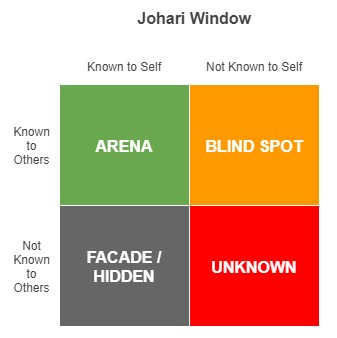Effective communication is essential for building strong relationships and developing self-awareness. When communication breaks down or misunderstandings occur, it can strain personal connections. The Johari Window model offers a valuable framework to enhance communication and foster mutual understanding.
INTRODUCTION
The Johari Window is a psychological tool created by Joseph Luft and Harrington Ingham in 1955 that provides a framework for understanding self-awareness and communication.
Tag: johari window (2)
The model, named after its creators, is depicted as a four-quadrant window, each representing different aspects of our personality and self-awareness.
The Johari Window in Conversation
Conversation is essential to human interaction, and plays a pivotal role in forming and maintaining relationships. It can be viewed through the lens of the Johari Window, which emphasizes its four quadrants: the Open Area, the Blind Area, the Hidden Area, and the Unknown Area.
Each quadrant offers insights into conversation dynamics, highlighting the interplay between self-disclosure, feedback, and mutual understanding.
THE OPEN AREA (ARENA)
 The Open Area represents aspects of ourselves that we are aware of and share openly with others. This quadrant is crucial for effective communication, as it encompasses information, feelings, and experiences that are mutually known. The Open Area fosters trust and transparency in conversations, allowing us to connect more deeply. Discussing shared interests, expressing emotions, or collaborating on common goals enhances mutual understanding and strengthens relationships.
The Open Area represents aspects of ourselves that we are aware of and share openly with others. This quadrant is crucial for effective communication, as it encompasses information, feelings, and experiences that are mutually known. The Open Area fosters trust and transparency in conversations, allowing us to connect more deeply. Discussing shared interests, expressing emotions, or collaborating on common goals enhances mutual understanding and strengthens relationships.
The Open Area can be expanded through conversation by increasing self-disclosure and encouraging feedback. Self-disclosure involves sharing personal thoughts and feelings, while feedback consists of receiving insights from others about ourselves. This reciprocal exchange nurtures an environment of openness and authenticity, enabling us to understand each other better and ourselves. As a result, conversations become more meaningful and constructive, paving the way for personal and relational growth.
THE BLIND AREA (BLIND SPOT)
The Blind Area consists of aspects of ourselves that others perceive, but we are unaware of. This quadrant can significantly impact interpersonal dynamics in conversations, as unrecognized behaviors, attitudes, or traits may influence how we are perceived. Blind spots can lead to misunderstandings or conflicts if not addressed. For example, we may unknowingly dominate conversations, making others feel unheard or undervalued.
Conversations are essential to minimizing the Blind Area. Constructive feedback within these conversations can illuminate blind spots, offering valuable insights into how our actions and words impact others. Engaging in active listening and fostering a non-judgmental space for feedback supports this process. Being open to others’ perspectives enhances our self-awareness, leading to more balanced and empathetic conversations.
THE HIDDEN AREA (FACADE)
The Hidden Area includes aspects of ourselves that we are aware of but choose to keep hidden from others. In conversations, this quadrant represents the information, thoughts, and feelings we withhold due to fear, insecurity, or a desire to maintain privacy. While it is natural to have a Hidden Area, excessive secrecy can hinder genuine connection and trust.
Conversation is key to reducing the Hidden Area through self-disclosure. We can build trust and intimacy in our relationships by gradually sharing personal information. However, it’s important to manage the level of self-disclosure carefully, as oversharing can overwhelm others or make us vulnerable. Balancing openness with discretion ensures conversations remain respectful and considerate, fostering a safe space for mutual exchange.
THE UNKNOWN AREA
The Unknown Area comprises aspects of ourselves that are unknown to ourselves and others. This quadrant represents untapped potential, hidden talents, or unconscious behaviors. Conversations can play a transformative role in uncovering the Unknown Area. We can explore new perspectives, challenge assumptions, and discover latent abilities through dialogue.
Exploratory conversations, such as brainstorming sessions or deep philosophical discussions, can stimulate self-discovery and personal growth. By engaging in open-ended and reflective dialogues, we can tap into our subconscious mind, revealing hidden dimensions of our personality. Seeking diverse viewpoints and embracing uncertainty can expand the Unknown Area, leading to a more holistic understanding of ourselves and others.
Improving communication and self-awareness through the Johari Window can strengthen our relationships. By being open to feedback, we better understand ourselves and others, leading to deeper connections and more meaningful conversations. This approach encourages honest dialogue, fostering mutual understanding, trust, and personal growth.
POST NAVIGATION
CHAPTER NAVIGATION
SEARCH
Blook SearchGoogle Web Search
Photo Credits: Midjourney ()
If you enjoy my work and find it valuable, please consider giving me a little support. Your donation will help cover some of my website hosting expenses.
Make a donation

